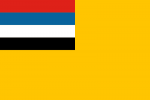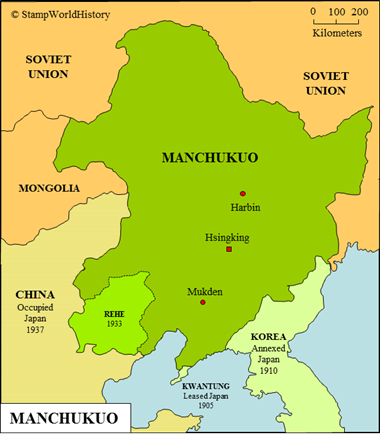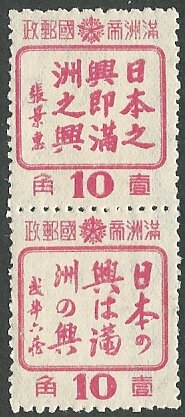滿洲國

Manchukuo
Quick reference
General issues: Republic 1932-1934, Empire 1934-1945
Country name on general issues: Manchukuo in Chinese characters, no country name
Currency: 1 Yuan = 100 Fen 1932-1945
Population: 35 338 in 1936
Political history Manchukuo
Manchukuo is located eastern Asia, roughly equaling the Chinese region of Manchuria. Manchuria, in the 19th century, is de jure part of China but is, since the end of the 19th century, contested by Russia and Japan. In 1900, Russia has invaded Manchuria as part of the international coalition that intervenes in China after the Boxer rebellion to enforce continuation of the extraterritorial rights of the foreign powers in China. Russia has, subsequently, occupied Manchuria. Japan equally has interests in Manchuria: Manchuria is to play a vital role in the Japanese expansionist policy by providing an additional industrial potential. The conflicting interests lead to the Russo-Japanese War of 1904-1905. Japan is victorious and Russia is forced to withdraw from Manchuria, that – although de jure still under Chinese sovereignty – becomes part of the Japanese sphere of influence. In 1931, Japan occupies Manchuria. In 1932, it proclaims the nominally independent republic of Manchukuo. In 1934, Manchukuo becomes an empire with Pu-Yi on the throne, the last heir to the Chinese Qing dynasty.
Part of Manchuria is the Liaodong peninsula, also known as the Kwantung – Guandong in pinyin – leased territory. Kwantung is leased to Russia until 1905 and to Japan from 1905. From 1932, the lease is paid to Manchukuo. The territory of Manchukuo itself is, in 1933, further extended by the annexation of the Chinese province of Rehe.
The invasion of Manchuria by Japan is condemned by the international community, resulting in the withdrawal of Japan from the League of Nations in 1936. Meanwhile, in the 1930’s, the industrial potential of Manchukuo is rapidly developed, thus preparing Japan for WWII.
In 1945, Soviet Russia ends the neutrality pact it had with Japan and invades Manchuria, putting an end to the empire of Manchukuo. Manchuria is ceded back to China in 1946.
Postal history Manchukuo
Manchukuo has issued stamps from 1932 until 1945. Between 1935 and 1937, several sets of stamps were issued with no country name inscribed. These were valid for all postal use but issued specifically for use on mail to China. China did not recognize Manchukuo and did not accept stamps with the country’s name on them – even the country name in Manchukuo cancels was made unrecognizable by the Chinese postal authorities.
Many local overprints on stamps of Manchukuo exist from the period just after WWII. Overprints that were applied by officials from the Chinese communist and the nationalist parties, both struggling to gain control of Manchuria. These were superseded by issues for the Northeast Liberation area, as issued by the communists and for the Northeastern Provinces, as issued by the nationalists. All these to be superseded by the issues of the Peoples republic of China in 1951. Please refer to the profiles of China, Republic and China, Peoples Republic.
Album pages
← Previous page: MaldivesNext page: Mongolia →




Dear Gerben.
I send you comment about Manchoukuo stamps. The sets of the stamps without inscription Manchoukuo were issued in 1935-37. These stamps were used for Manchoukuo – China mail (China didn‘t recognize Manchoukuo and the stamps with the inscriptions Manchoukuo). Gedi
Gedi, thanks for pointing this out. I was not aware of these issues but indeed they are mentioned as such in the catalogs. I will add a note in the country profile. I appreciate this type of reply very much as it helps to improve the content of the site – thanks again.